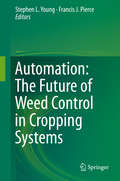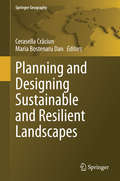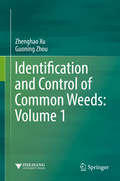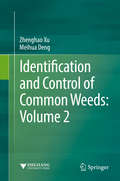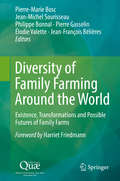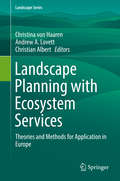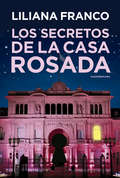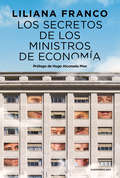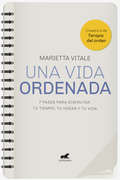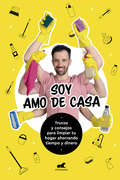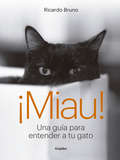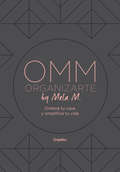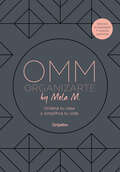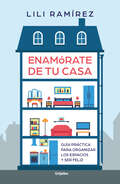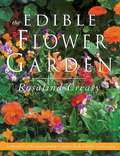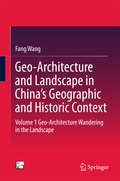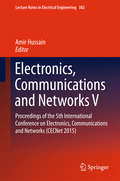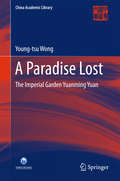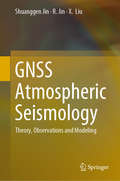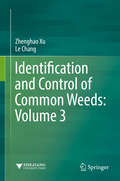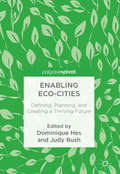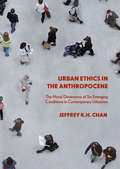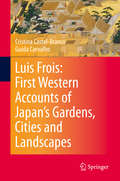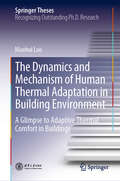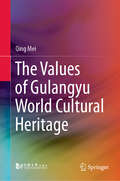- Table View
- List View
Automation: The Future Of Weed Control In Cropping Systems
by Stephen L. Young Francis J. PierceTechnology is rapidly advancing in all areas of society, including agriculture. In both conventional and organic systems, there is a need to apply technology beyond our current approach to improve the efficiency and economics of management. Weeds, in particular, have been part of cropping systems for centuries often being ranked as the number one production cost. Now, public demand for a sustainably grown product has created economic incentives for producers to improve their practices, yet the development of advanced weed control tools beyond biotech has lagged behind. An opportunity has been created for engineers and weed scientists to pool their knowledge and work together to 'fill the gap' in managing weeds in crops. Never before has there been such pressure to produce more with less in order to sustain our economies and environments. This book is the first to provide a radically new approach to weed management that could change cropping systems both now and in the future.
Planning and Designing Sustainable and Resilient Landscapes
by Cerasella Crăciun Maria Bostenaru DanThis book deals with planning issues in landscape architecture, which start at the evaluation of the existing fabric of society, its history and memory, approached and conserved through photography, film and scenographic installations, a way in which the archetypes can be investigated, be it industrial derelict sites or already green spaces and cultural landscapes. It provides approaches to intervention, through rehabilitation and upgrade, eventually in participative manner. To such evaluation and promotion a couple of disciplines can contribute such as history of art, geography and communication science and of course (landscape) architecture. The field of landscape architecture reunites points of view from such different disciplines with a view to an active approach a contemporary intervention or conservation. The book presents case studies from several European countries (Romania, Germany, Austria, Italy, Portugal) mostly for large landscape in the outskirts of the cities and in the parks.
Identification and Control of Common Weeds: Volume 1
by Zhenghao Xu Guoning ZhouThis book introduces readers to nearly 600 common weeds. In addition to essential information, each chapter includes photos for a specific type of weed to show its morphology in different growth periods, such as seedling, root, flower, fruit, and mature plant. The book also discusses control measures, including agricultural, chemical, physical, biological, and comprehensive methods. The Volume1 mainly focuses on 126 species of grass weeds and 34 species of sedge weeds. With the development of society and economics, weeds have become a recurring problem. In particular, the exotic, invasive, and quarantine weeds have spread dramatically and rapidly. On the other hand, many people, even those who are engaged in weed control, do not (or cannot) distinguish between weeds. Thus there is significant demand for illustrations of weed morphologies, as well as information on their control measures. This book offers a valuable, practical guide for all those working in the fields of crop cultivation, plant protection and quarantine management.
Identification and Control of Common Weeds: Volume 2
by Zhenghao Xu Meihua DengThis book introduces readers to nearly 600 common weeds. In addition to essential information, each chapter includes photos for a specific type of weed to show its morphology in different growth periods, such as seedling, root, flower, fruit, and mature plant. The book also discusses control measures, including agricultural, chemical, physical, biological, and comprehensive methods. The Volume2 mainly focuses on fern and 216 species of weeds of magnoliids or dicotyledoneae. With the development of society and economics, weeds have become a recurring problem. In particular, the exotic, invasive, and quarantine weeds have spread dramatically and rapidly. On the other hand, many people, even those who are engaged in weed control, do not (or cannot) distinguish between weeds. Thus there is significant demand for illustrations of weed morphologies, as well as information on their control measures. This book offers a valuable, practical guide for all those working in the fields of crop cultivation, plant protection and quarantine management.
Diversity of Family Farming Around the World: Existence, Transformations And Possible Futures Of Family Farms
by Pierre-Marie Bosc Jean-Michel Sourisseau Philippe Bonnal Pierre Gasselin Élodie Valette Jean-François BélièresThis book aims at explaining the nature and strength of the links between the families and their farms looking at their diversity throughout the world. To do so, it documents family farming diversity by using the sustainable rural livelihood (SRL) framework exploring their ability to adapt and transform to changing environments. In 18 case studies in Asia, Africa, Latin America and Europe, it shows how family farms resist under adverse conditions, seize new opportunities and permanently transform. Family farms, far from being backwards are potential solutions to face the current challenges and shape a new future for agriculture taking advantage of their local knowledge and capacity to cope with external constraints. Many coauthors of the book have both an empirical and theoretical experience of family farming in developed and developing countries and their related institutions. They specify «what makes and means family» in family farming and the diversity of their expertise draws a wide and original picture of this resilient way of farming throughout the world.
Landscape Planning with Ecosystem Services: Theories and Methods for Application in Europe (Landscape Series #24)
by Christina Von Haaren Andrew A. Lovett Christian AlbertHuman well-being depends in many ways on maintaining the stock of natural resources which deliver the services from which human’s benefit. However, these resources and flows of services are increasingly threatened by unsustainable and competing land uses. Particular threats exist to those public goods whose values are not well-represented in markets or whose deterioration will only affect future generations. As market forces alone are not sufficient, effective means for local and regional planning are needed in order to safeguard scarce natural resources, coordinate land uses and create sustainable landscape structures. This book argues that a solution to such challenges in Europe can be found by merging the landscape planning tradition with ecosystem services concepts. Landscape planning has strengths in recognition of public benefits and implementation mechanisms, while the ecosystem services approach makes the connection between the status of natural assets and human well-being more explicit. It can also provide an economic perspective, focused on individual preferences and benefits, which helps validate the acceptability of environmental planning goals. Thus linking landscape planning and ecosystem services provides a two-way benefit, creating a usable science to meet the needs of local and regional decision making. The book is structured around the Driving forces-Pressures-States-Impacts-Responses framework, providing an introduction to relevant concepts, methodologies and techniques. It presents a new, ecosystem services-informed, approach to landscape planning that constitutes both a framework and toolbox for students and practitioners to address the environmental and landscape challenges of 21st century Europe.
Los secretos de la Casa Rosada
by Liliana FrancoLas mejores anécdotas que desde el regreso de la democracia esconden las paredes de la Casa Rosada, la Meca con la que sueñan todos los políticos. Como todas las casas, la Rosada tiene vida cotidiana. Pero su día a día no se parece al de todos los hogares, porque las decisiones que allí se cocinan modifican la existencia de millones de personas. Poca gente es parte de esa vida: además de los funcionarios y los empleados, están los periodistas acreditados, que permanecen allí muchas horas para conseguir noticias de primera mano. Detrás de cada novedad que ellos divulgan hay historias, anécdotas y episodios que merecen ser conocidos. Un militar se creyó presidente y cuando llegó se enteró de que no lo era. Durante el juicio a las Juntas en 1985, hubo un Falcon viejo, con la chapa oxidada, estacionado varios días en la vereda. Antonio Banderas comió su primer choripán en la terraza, donde por esos años trabajaban telefonistas hot y acudían las "chicas del bolsito". Hay una palmera moribunda en el patio y un ascensor del que Mauricio Macri desconfía. Por la Rosada pasaron muchos funcionarios memorables, y cada presidente dejó algún recuerdo a quienes lo trataron durante su mandato. Liliana Franco -que trabajó en ella casi dos décadas- reunió estas y otras historias que, como un espejo deformado, reflejan a su modo los distintos períodos que atravesó nuestra democracia.
Los secretos de los ministros de Economía
by Liliana FrancoLas mejores anécdotas que desde el regreso de la democracia esconden las paredes y pasillos del Palacio de Hacienda. ¿Cómo se gestó la salida de Luis Caputo del Banco Central? ¿A qué ministro apodan Chocoarroz? ¿Qué hizo Amado Boudou con su despacho? ¿Cómo recuerdan en el Ministerio a Roberto Lavagna, Alfonso Prat-Gay, Axel Kicillof y Guillermo Nielsen? ¿Cómo fueron las eternas peleas con el Fondo Monetario Internacional? ¿Quién fue el mejor jefe? ¿Y el peor? La preocupación por la economía ocupa los primeros puestos de las encuestas porque -para bien o para mal- afecta la vida cotidiana y determina nuestro futuro. Pensamos que, antes de ser tomadas, las medidas son analizadas, sopesadas y debatidas por expertos. Si la realidad a veces nos hace dudar de ello, Los secretos de los ministros de Economía revela que ese recelo puede ser acertado. Como hizo en Los secretos de la Casa Rosada, Liliana Franco nos guía esta vez por las oficinas, las salas y los pasillos del Palacio de Hacienda. Tras años de trabajo en ese ámbito, ella como pocos conoce el detrás de escena de muchas decisiones controversiales y los aspectos ocultos del ascenso o la caída de personajes clave. A su manera, las historias de este libro muestran un costado desconocido de las formas en que los gobernantes y sus funcionarios más cercanos ejercen el poder; y pueden explicar cómo nos va...
Una vida ordenada: 7 pasos para disfrutar tu tiempo, tu hogar y tu vida
by Marietta VitaleUna vida ordenada, el nuevo libro de la interior planner Marietta Vitale, tiene como objetivo sumar la organización personal y hacer foco en nuestra primera casa, es decir, nuestro cuerpo. ¿Cómo hacer para que nos rindan las 24 horas del día, que parecen no alcanzar nunca para todo lo que debemos -y queremos- hacer? El fin de este libro es articular el orden de los espacios con la organización personal. Lograr un día a día más simple es posible. ¡Basta de "no tengo tiempo para nada"! En siete pasos, Marietta Vitale propone aprovechar el tiempo de la mejor manera. La autora ha ayudado a centenares de personas a cambiar su vida a partir del orden. Sin embargo, a veces otros aspectos de la vida siguen desorganizados. Para estar en equilibrio, este es el momento de centrarte en tus tiempos y tu cuerpo. La creadora de Terapia del orden ahora va un paso más allá con una guía pensada para que, a través del orden, hagas todo lo que querés, maximizando tu bienestar y el de quienes te rodean.
Soy Amo de Casa: Trucos y consejos para limpiar tu hogar ahorrando tiempo y dinero
by Soy Amo de CasaAprendé a limpiar organizadamente con productos hechos por vos y convertí tu casa en tu lugar en el mundo. Tu casa debería ser un lugar al quieras volver siempre. Y para eso, además de ordenada, tiene que estar limpia. Soy Amo de Casa te muestra las mejores estrategias para lograrlo, a la vez que te enseña cómo hacer tus propios productos de limpieza con solo dos o tres ingredientes. ¿Sabías que el vinagre hace magia? ¿A qué tenés que dedicarle más atención y con qué frecuencia? ¿Qué podés hacer con esa mancha que no sale con nada? ¿Y con el sarro de la bañera? ¿Es posible recuperar una olla quemada o dejar impecable una pava? ¿Hay una forma eficaz de limpiar azulejos y pisos? ¿Cómo lograr que la ropa no quede arrugada? ¿Cómo quitarles el olor a las zapatillas? Soy Amo de Casa es tu aliado perfecto. El experto que te ayudará a transformar tu casa en tu lugar en el mundo.
¡Miau!: Una guía para entender a tu gato
by Ricardo BrunoUna guía para saber por qué los gatos hacen lo que hacen y para aprender a comportarnos con ellos. Entender a ese animal fascinante es la llave para disfrutar de su compañía. Por qué se dice que los perros y los gatos tienen patrones de conducta diametralmente opuestos. Cómo es un gato "normal". Su comportamiento social. Su vida cotidiana. El cachorro, el adulto y el anciano. Gatos outdoor y gatos indoor. Machos y hembras. Qué le pasa a un gato que se muestra agresivo. Espacio y territorio gatunos. Sonidos, posturas, gestos y olores: el sistema de comunicación de nuestro gato y cómo descifrarlo. Qué nos está diciendo cuando nos acerca sus presas muertas. La cola. Las orejas. Por qué marca objetos y superficies con su pis, entierra sus excrementos o invierte horas en acicalarse. El cuerpo del gato: una máquina perfecta. Huesos, músculos, circulación, aparato digestivo, el pelo. Su increíble olfato y su potente visión nocturna. ¿Dulce o salado?: el gusto gatuno. Bigotes de equilibrista. Por qué le fascinan las alturas (dentro de nuestra casa). Acomodándose en el aire: la belleza y la perfección de su cuerpo cuando salta desde lo alto. Por qué es inútil invertir tiempo y esfuerzo en acostumbrar a un gato a que salga a caminar, gaste energía y lleve una vida más entretenida. El mejor método a la hora de educarlo. Por qué ama masticar nuestra ropa, arruinar nuestros muebles, hacer mil piruetas para intentar atrapar una gota de agua de la canilla o dormir de día y molestar a la noche. Los gatos que viven en hogares pequeños sin acceso al exterior o tienen dueños que no les permiten salir libremente. Los gatos que se van a otras casas y vagabundean de noche cuando tienen acceso al exterior. Cuáles son los signos de vejez en un gato doméstico. ¿Adoptar un gato bebé o un gato adulto? Ideas falsas (y no tanto) sobre los gatos. Cómo hacerlos felices. Incluye hermosas fotos, una guía felina de estilo y buenos modales, primeros auxilios y una lista con los Diez Mandamientos gatunos.
OMM Organizarte by Mela M.: Ordená tu casa y simplificá tu vida
by Melanie MelhemMelanie Melhem, organizadora profesional, propone una guía práctica para llevar una existencia liviana, en la que el orden y la organización no se conviertan en una obsesión, sino en un hábito que nos brinde más calidad de vida, armonía y placer visual. La organización es el camino hacia una vida más simple, pero para ordenar es necesario soltar, y eso es algo que nos cuesta mucho. Hay personas que conservan guías telefónicas o volantes de deliveries con números que están a un par de clicks en internet. En los cajones de la cocina suele haber utensilios rotos. En los placares, demasiadas prendas de ropa que ya no usamos. Y los juguetes de los chicos se adueñan de la casa. Entonces el problema no es la falta de espacio, sino el exceso de cosas. ¿De qué sirve una biblioteca con libros que no vamos a leer? ¿Por cuánto tiempo hay que archivar las facturas de luz y de gas? ¿Por qué, de pronto, tenemos la alacena llena de productos vencidos? ¿Para qué guardamos cincuenta collares si siempre usamos los mismos tres? ¿Cómo conviene organizar el lugar de trabajo? ¿Y armar una valija? ¿Cómo inculcarles la costumbre del orden a los chicos sin volverlos locos? Hoy las casas son más chicas que hace cincuenta años, por eso debemos ser conscientes y responsables acerca de los elementos que acumulamos. La house planner argentina Melanie Melhem propone varios consejos aplicados al mundo occidental para llevar una existencia más liviana. Y para que el orden y la organización no se conviertan en una obsesión, sino en un hábito que nos brinde una mayor calidad de vida.
OMM Organizarte by Mela M.: Ordená tu casa y simplificá tu vida
by Melanie MelhemMelanie Melhem, organizadora profesional, propone una guía práctica para llevar una existencia liviana, en la que el orden y la organización no se conviertan en una obsesión, sino en un hábito que nos brinde más calidad de vida, armonía y placer visual. La organización es el camino hacia una vida más simple, pero para ordenar es necesario soltar, y eso es algo que nos cuesta mucho. Hay personas que conservan guías telefónicas o volantes de deliveries con números que están a un par de clicks en internet. En los cajones de la cocina suele haber utensilios rotos. En los placares, demasiadas prendas de ropa que ya no usamos. Y los juguetes de los chicos se adueñan de la casa. Entonces el problema no es la falta de espacio, sino el exceso de cosas. ¿De qué sirve una biblioteca con libros que no vamos a leer? ¿Por cuánto tiempo hay que archivar las facturas de luz y de gas? ¿Por qué, de pronto, tenemos la alacena llena de productos vencidos? ¿Para qué guardamos cincuenta collares si siempre usamos los mismos tres? ¿Cómo conviene organizar el lugar de trabajo? ¿Y armar una valija? ¿Cómo inculcarles la costumbre del orden a los chicos sin volverlos locos? Hoy las casas son más chicas que hace cincuenta años, por eso debemos ser conscientes y responsables acerca de los elementos que acumulamos. La house planner argentina Melanie Melhem propone varios consejos aplicados al mundo occidental para llevar una existencia más liviana. Y para que el orden y la organización no se conviertan en una obsesión, sino en un hábito que nos brinde una mayor calidad de vida.
Enamórate de tu casa
by Lili RamírezEste libro te cambiará la idea de que eres desordenado por naturaleza y te ayudará a encontrar el bienestar a través de la organización de tu casa. Está comprobado que ordenar los espacios trae muchos beneficios: ayuda a enfocarse y a ser más productivos, reduce el estrés, mejora el sueño y genera felicidad. Parece una tarea titánica poner todo en su sitio, pero esta organizadora profesional te mostrará que no es difícil y te acompañará en el proceso de ordenar cada espacio: el clóset, la cocina, el baño, el depósito, la biblioteca. Además, te enseñará a planear una mudanza sin problemas, a preparar una maleta de viaje ligera, a tener un espacio adecuado de trabajo, y te dirá cómo guardar la decoración de Navidad para que el próximo año no sea una pesadilla sacar el árbol. Todo estará enfocado en un objetivo: volver a enamorarte de tu casa y disfrutar de ese lugar donde recargas energía.
The Edible Flower Garden
by Rosalind CreasyA comprehensive guide to selecting and growing flowers that can be used for cookery, both as garnishes and as ingredients.
Geo-Architecture and Landscape in China's Geographic and Historic Context
by Fang WangThis book explores the concept of geo-architecture by analyzing the ways architectures are related to the local geography, including mingling or contrasting with surrounding landscape, adapting to mountainous or aquatic terrain, and selection of construction materials. Architectures build with such skillfully contrived strategies and techniques have become live exhibit of folk customs and served to record in profound detail the long history of mankind's recognition of nature. The combined effect is such that the architecture grows out of the surrounding natural and human environment. This book is the third of a 4-volume book series. The series develops the innovative concept of "geo-architecture" by exploring the myriad influences of natural, human and historical factors upon architecture. These influences are considered in three categories, namely, interaction between architecture and nature, interaction between architecture and its human users and change in architecture over time--each category serves as a lens. Augmenting these lenses is the Time-Person-Place concept applied different geographic. The analysis ultimately focuses on two aspects: geographic influence on architecture and architectural response to geography. The over 1000 pictures of case architectures enriches the study with stunning and unique visual angles. "This unprecedented work will be a unique and valuable contribution to the literature. Integrating as it does the disciplines of architecture, landscape architecture, and geography, Wang Fang's voice is original, compelling, and will be much appreciated by English-speaking readers (and inside China, too, I can only imagine. )" Stephen M Ervin Assistant Dean Graduate School of Design, Harvard University July 2nd, 2013 "One reason for why there would be interest is because her research would fill some significant gaps in the literature. What is novel about Dr. Wang's series is that she further extends this intellectual project of looking at Chinese architecture through Chinese eyes, by taking it one provocative step further. " Annette M. Kim Associate Professor Department of Urban Studies and Planning, M. I. T. July 1st, 2013
Electronics, Communications and Networks V
by Amir HussainThis book comprises peer-reviewed contributions presented at the 5th International Conference on Electronics, Communications and Networks (CECNet 2015), held in Shanghai, China, 12-15 December, 2015. It includes new multi-disciplinary topics spanning a unique depth and breadth of cutting-edge research areas in Electronic Engineering, Communications and Networks, and Computer Technology. More generally, it is of interest to academics, students and professionals involved in Consumer Electronics Technology, Communication Engineering and Technology, Wireless Communication Systems and Technology, and Computer Engineering and Technology.
A Paradise Lost: The Imperial Garden Yuanming Yuan (China Academic Library)
by Young-Tsu WongThis book is aimed at readers and researchers who are interested in Chinese garden architecture, the rise and fall of Yuanming Yuan and the history of the Qing dynasty. It is the first comprehensive study of the palatial garden complex in a Western language, and is amply illustrated with photographs and original drawings. Wong Young-tsu's engaging writing style brings 'the garden of perfect brightness' to life as he leads readers on a grand tour of its architecture and history.
GNSS Atmospheric Seismology: Theory, Observations and Modeling
by Shuanggen Jin R. Jin X. LiuGNSS can detect the seismic atmospheric-ionospheric variations, which can be used to investigate the seismo-atmospheric disturbance characteristics and provide insights on the earthquake. This book presents the theory, methods, results, and modeling of GNSS atmospheric seismology. Sesimo-tropospheric anomalies, Pre-/Co-/Post-seismic ionospheric disturbances, epicenter estimation, tsunami and volcano ionospheric disturbances, and volcanic plumes detection with GNSS will be presented and discussed per chapter in the book.
Identification and Control of Common Weeds: Volume 3
by Zhenghao Xu Le ChangThis book introduces readers to nearly 600 common weeds. In addition to essential information, each chapter includes photos for a specific type of weed to show its morphology in different growth periods, such as seedling, root, flower, fruit, and mature plant. The book also discusses control measures, including agricultural, chemical, physical, biological, and comprehensive methods. The Volume 3 mainly focuses on 252 Species of Dicotyledonous and Monocotyledonous Weeds along with 2 Species of Liverworts and Mosses. With the development of society and economics, weeds have become a recurring problem. In particular, the exotic, invasive, and quarantine weeds have spread dramatically and rapidly. On the other hand, many people, even those who are engaged in weed control, do not (or cannot) distinguish between weeds. Thus there is significant demand for illustrations of weed morphologies, as well as information on their control measures. This book offers a valuable, practical guide for all those working in the fields of crop cultivation, plant protection and quarantine management.
Enabling Eco-Cities
by Dominique Hes Judy BushCities are striving to become more resilient, adaptive and sustainable; this requires new ways of governing and developing the city. This book features chapters by researchers using regenerative development and transitions theories to envisage how Eco-Cities could be planned, designed and created, and concludes with practical tools and an outline of how this evolution could be facilitated. It examines two major questions: How can we use understandings of Eco-Cities to address the legacy of urban built form and existing practices which often make it difficult to create the systemic changes needed? And what are the elements of complex urban places and spaces that will enable the planning, creation and evolution of thriving cities?The book will appeal to planners, city makers, urban researchers, students and practitioners, including planners, designers, architects and sustainability managers, and all those seeking to envisage the steps along the path to thriving cities of the future.
Urban Ethics in the Anthropocene: The Moral Dimensions of Six Emerging Conditions in Contemporary Urbanism
by Jeffrey K.H. ChanIncreasingly, we live in an environment of our own making: a ‘world as design’ over the natural world. For more than half of the global population, this environment is also thoroughly urban. But what does a global urban condition mean for the human condition? How does the design of the city and the urban process, in response to the issues and challenges of the Anthropocene, produce new ethical categories, shape new moral identities and relations, and bring about consequences that are also morally significant? In other words, how does the urban shape the ethical—and in what ways? Conversely, how can ethics reveal relations and realities of the urban that often go unnoticed? This book marks the first systematic study of the city through the ethical perspective in the context of the Anthropocene. Six emergent urban conditions are examined, namely, precarity, propinquity, conflict, serendipity, fear and the urban commons.
Luis Frois: First Western Accounts of Japan's Gardens, Cities and Landscapes
by Cristina Castel-Branco Guida CarvalhoThis book focuses on Luis Frois, a 16th-century Portuguese Jesuit and chronicler, who recorded his impressions of Japanese gardens, cities and building practices, tea-drinking rituals, Japan’s unification efforts, cultural traditions, and the many differences between Europe and Japan in remarkable manuscripts almost lost to time. This research also draws on other Portuguese descriptions from contemporary sources spanning the years 1543 – 1597, later validated by Japanese history and iconography. Importantly, explorer Jorge Alvares recorded his experiences of discovery, prompting St. Francis Xavier to visit Japan in 1549, thus ushering in the “Christian Century” in Japan.During this long period of accord and reciprocal curiosity, the Portuguese wrote in excess of 1500 pages of letters to European Jesuits that detail their impressions of the island nation—not to mention their observations of powerful public figures such as Oda Nobunaga, Toyotomi Hideyoshi, and Sen no Rikyu. In addition to examining these letters, the authors translated and researched early descriptions of 23 gardens in Kyoto and Nara and 9 important cities—later visited by the authors, sketched, photographed and compared with the imagery painted on 16th-century Japanese screens.However, the data gathered for this project was found mainly within five large volumes of Frois’ História do Japão (2500 pages) and his Treaty on Contradictions—two incomparable anthropological works that were unpublished until the mid-20th century for reasons detailed herein. His volumes continue to be explored for their insightful observations of places, cultural practices, and the formidable historical figures with whom he interacted.Thus, this book examines the world’s first globalization efforts that resulted in profitable commerce, the introduction of Portuguese firearms that changed Japan’s history, scientific advances, religious expansion, and many artistic exchanges that have endured the centuries.
The Dynamics and Mechanism of Human Thermal Adaptation in Building Environment: A Glimpse to Adaptive Thermal Comfort in Buildings (Springer Theses)
by Maohui LuoThis book focuses on human adaptive thermal comfort in the building environment and the balance between reducing building air conditioning energy and improving occupants’ thermal comfort. It examines the mechanism of human thermal adaptation using a newly developed adaptive heat balance model, and presents pioneering findings based on an on online survey, real building investigation, climate chamber experiments, and theoretical models. The book investigates three critical issues related to human thermal adaptation: (i) the dynamics of human thermal adaptation in the building environment; (ii) the basic rules and effects of human physiological acclimatization and psychological adaptation; and (iii) a new, adaptive, heat balance model describing behavioral adjustment, physiological acclimatization, psychological adaptation, and physical improvement effects. Providing the basis for establishing a more reasonable adaptive thermal comfort model, the book is a valuable reference resource for anyone interested in future building thermal environment evaluation criteria.
The Values of Gulangyu World Cultural Heritage
by Qing MeiThis book explores the core value of Gulangyu’s historical environment, using outstanding universal value and Sino-foreign cultural exchange as the framing aspects, based on the requirements for Gulangyu being recognized as a World Heritage Site. Using the existing historical buildings and sketches as prototypes, the book provides a scholarly discussion on China’s modern urban architecture and the ways in which its historical environment has been transformed, especially the reuse of design in its modern urban architecture, explored in six case studies on Gulangyu.
